Black calla lilies: varieties and growing in a pot
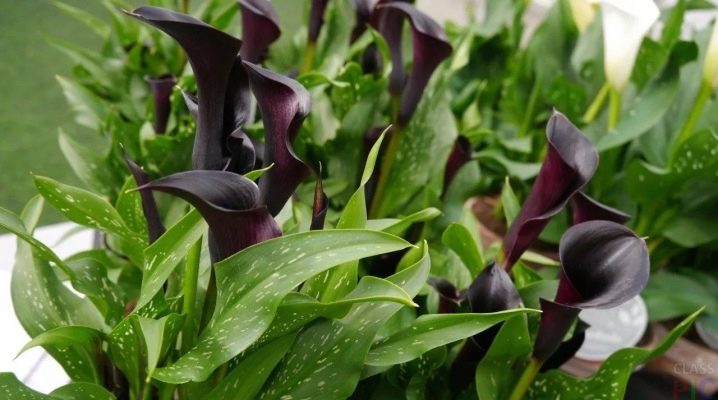
Black calla lilies are considered the most luxurious and exotic flowers. They grow beautifully both in the garden and in the apartment. This is a rather rare type of flowers.
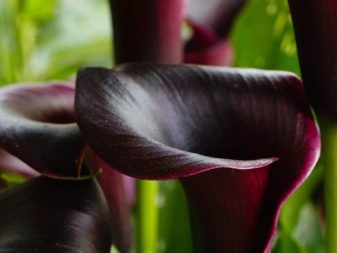
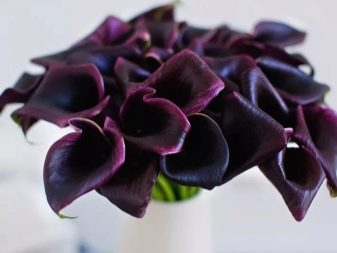
Peculiarities
Calla belongs to the Aroid family, it comes from South Africa, mainly grows near water bodies. The second name is zantedeschia. This name was given to the plant in honor of the botanist who discovered them. Calla lilies are also called calla lilies, but this name means wild plants, but decorative ones are still called calla lilies. Black calla lilies are perennial flowers, they have a stem, leaves, in addition, they bloom at regular intervals. They reproduce with the help of seeds.
There is an opinion that black calla lilies grow well exclusively in gardens, but this is not the case, they also take root in houses. Callas can reach quite large sizes, from one meter or more. Mostly flowering occurs from mid to late summer.
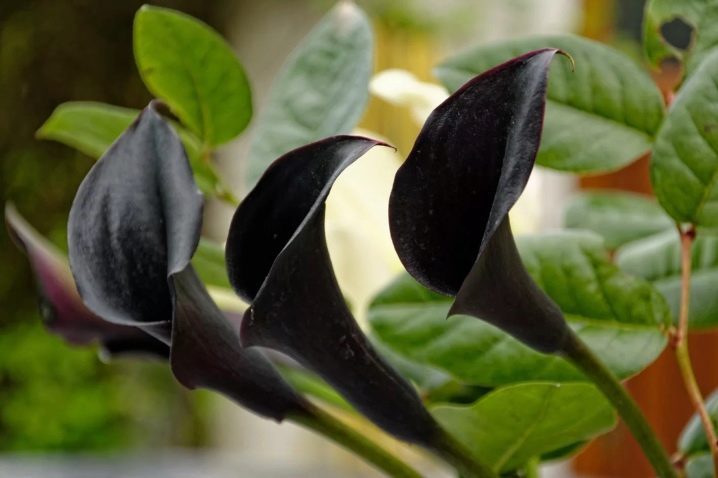
Several varieties of these flowers are known, and we will consider many of the decorative varieties in this article. All varieties have the same traits, for example, leaves that are located next to the roots. The flowers grow on the stem, which also has a bedspread and an ear. The bedspread is a wide, long sheet of bright green color, and it resembles a funnel that covers the ear. As a rule, flowers that are black in color have silvery or white blotches on the petals.
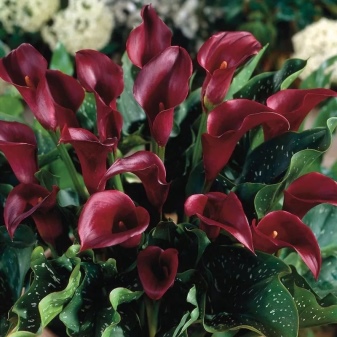
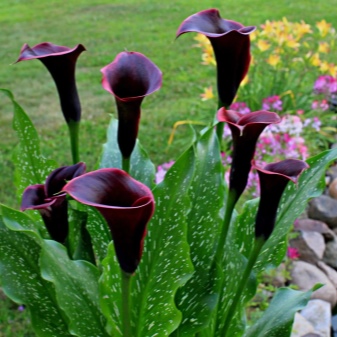
Description of varieties
Let's dwell on the most common varieties of black calla lilies.
Black forest
These calla lilies are very dainty, unusual flowers, and they will not allow you to look away from you. Plants are intended for growing both at home and in the garden. The garden version is very often used in the creation of various bouquets. And also it is quite often used for wedding compositions, therefore such calla lilies are also called "wedding flowers".
Calla lilies in height can reach 80 cm, but there are specimens and taller. Black Forest is a yellow ear and bedspread. Leaves grow up to 30 cm in length.
The color of the leaves is emerald, there are also blotches of white and silver color. In this regard, the leaves may resemble an arrowhead.

Black magic
The flowering of this variety at home takes place from mid-summer to early autumn. At this time, large yellow flowers appear, with a black center inside. There is almost no smell. Calla lilies reach a height of 15 cm, and in diameter - 10. It blooms for less than a month. Callas that are planted in the garden grow up to 90 cm, and have emerald, like wax leaves. Bloom for a month and a half. It is necessary to plant garden calla lilies from mid to late spring, when there will be no cold weather. It is also necessary to water it regularly so that the plant does not dry out.
As soon as flowering ends, then watering is necessary less often. It should be remembered that garden flowers do not tolerate cold, and during winter they must be transplanted into a pot, while it is necessary to clean the plants of dry leaves. Calla grows well in slightly moist, slightly acidic soil, and in a sunny location. If you cut a home flower, it will keep its freshness for a week.
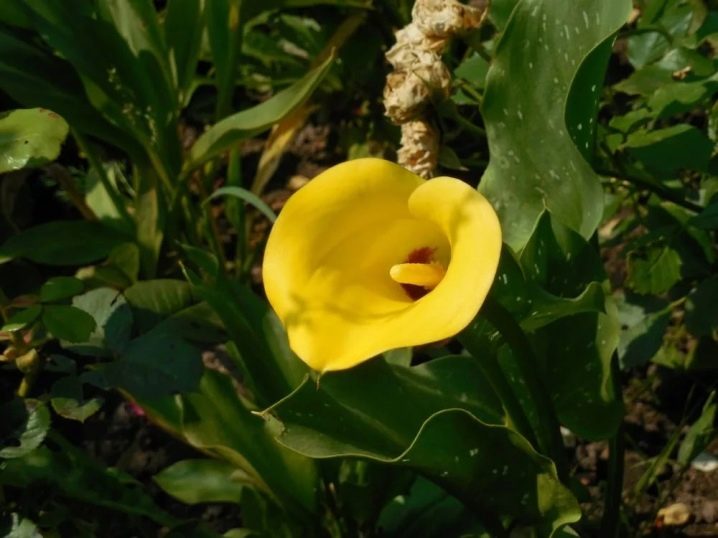
Black star
Such a flower is small in size, purple, almost black, with a pink edging. Good for container growing, can be up to 75 cm high.The aroma only appears in hot weather, and the smell of vanilla is clearly felt in it. Flowering occurs from mid-July to August.
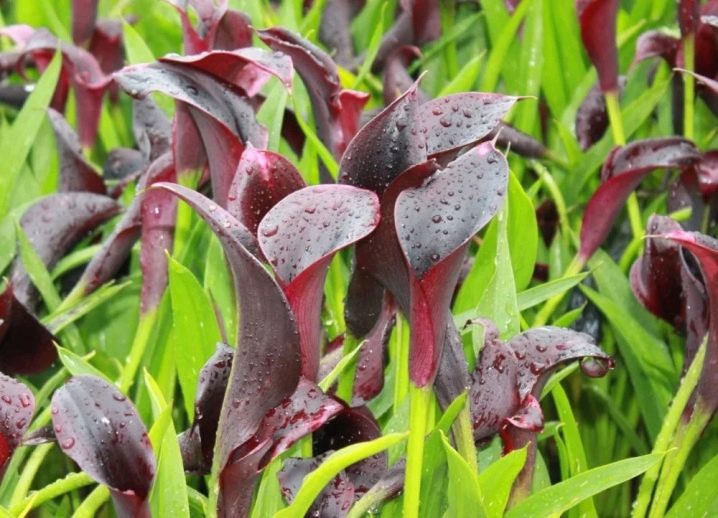
Black eyed lady
This species is called "black-eyed" because inside the flower itself there is a black color that resembles an eye. Calla has shades from bright yellow to pale yellow, almost white. She is unpretentious, but she needs the sun. The flower can be grown in the garden and at home. Very often, such a calla is planted on the banks of various reservoirs, where it looks very elegant. In warm weather, the aroma is felt much stronger than in cold weather. Flowering lasts 1.5 months.
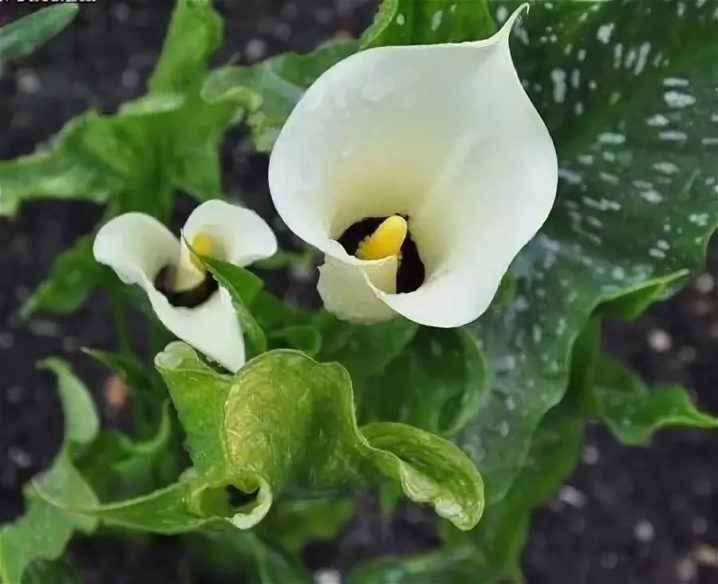
Home care
Callas need constant watering and spraying. At a time when flowering lasts, they need to be watered even more abundantly. But this must be done after the soil is completely dry. Water the calla lilies with settled water at room temperature. Since the plant loves slightly acidic soil, citric acid must be periodically added to the water.
It is very important that there is humid air in the room where the plant is located. If the flower is located in open ground, then it must also be sprayed. It is best to do this in the morning or at night, so that the plant has time to absorb all the water, since it will simply evaporate during the day. Calla lilies should be placed in a well-lit room, but protected from direct sunlight, since direct ultraviolet light can lead to drying of the flower and burns. This applies to both domestic and garden varieties.
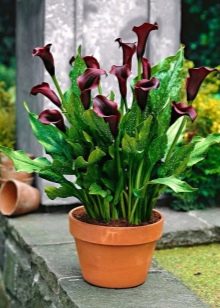
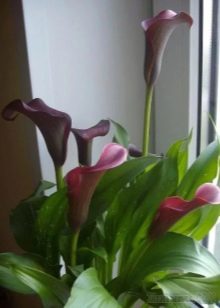
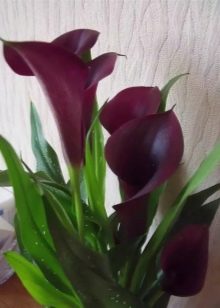
Also, the temperature in the room where the plant is located is very important. Different temperatures need to be maintained in a certain season. In summer, it should not exceed 24 degrees, but in winter it is better to keep the level at 15 degrees. And in no case should drafts and hypothermia be allowed... In the summer, the plant must be taken out into the air, but before doing this, it is better to immediately take care of protection from the effects of the sun and draft.
The container in which the black calla will grow is also advisable to choose in advance. A large pot or container is ideal. If the plant is placed in a small container, it will not bloom. Even conscientious care in this case will not help the calla lilies to bloom. For one black calla lily, you need to select a container whose diameter not less than 20 cm. The material should be taken porous so that the flower can breathe, and the excess moisture goes away.
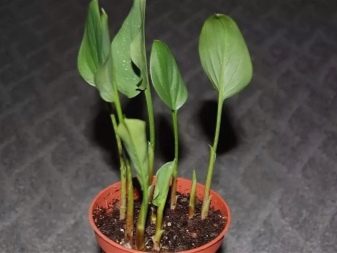

Diseases and their treatment
If you take care of calla lilies incorrectly, and also pick up the wrong soil, then there will be a high probability of disease.
To prevent the plant from dying, urgent measures must be taken.
Anthracnose is a fungal disease. It is quite common in these flowers. Signs:
- brown spots that increase over time, the edges turn red;
- mold appears;
- leaves dry up and curl;
- the stem weakens.
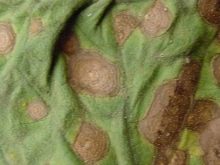
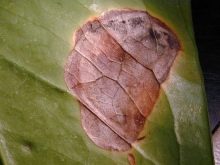

Causes:
- unsuitable temperature;
- high air humidity;
- abundant watering.
Treatment:
- remove affected leaves;
- reduce watering;
- remove from heating devices;
- treat with antifungal agents.
Remember that the fungus can spread to the soil, so be sure to remove leaves that have fallen off. If this does not help, then you should transplant the flower and process it well.
Powdery mildew appears in flowers already affected by the fungus. It manifests itself in such signs as a white bloom, which grows rapidly, and over time covers the entire plant. After a short time, the leaves begin to turn black, and then they die off.
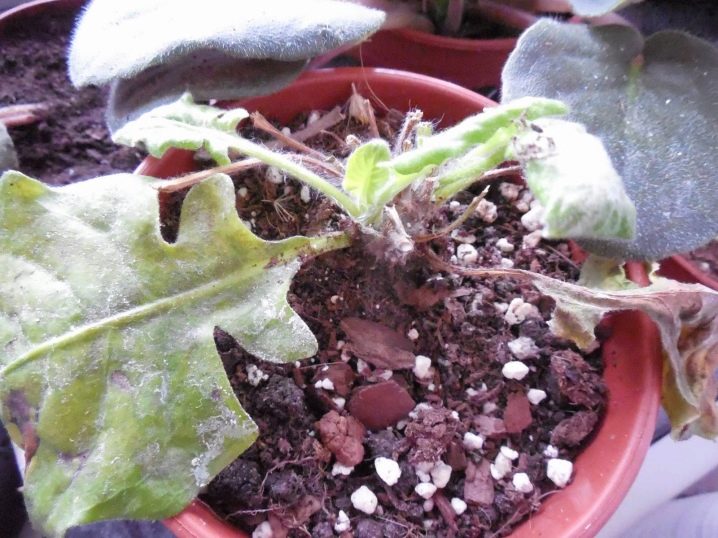
How to fight:
- remove the affected parts;
- treat with antifungal agents (1 time in 7 days, 3 weeks);
- reduce watering.
Also, this ailment can appear in dry soil.
For the rules for planting tubers, see below.




































































































The comment was sent successfully.